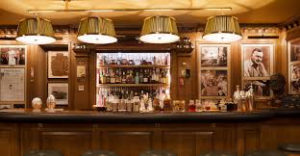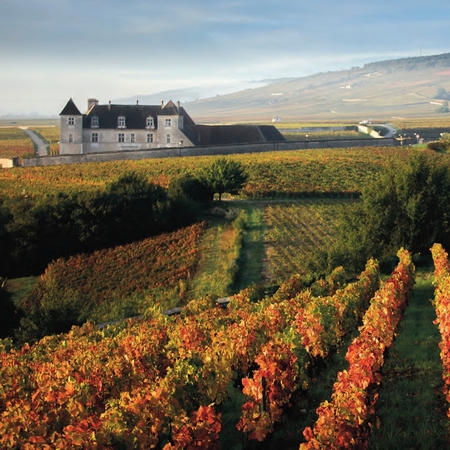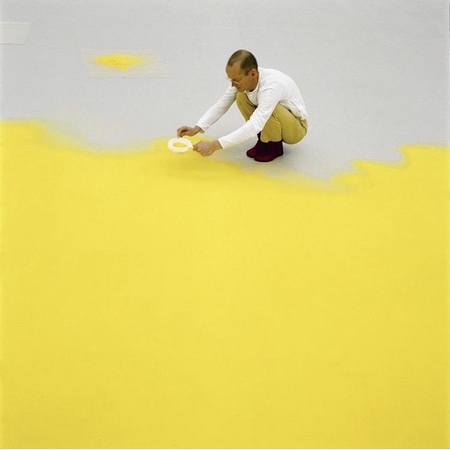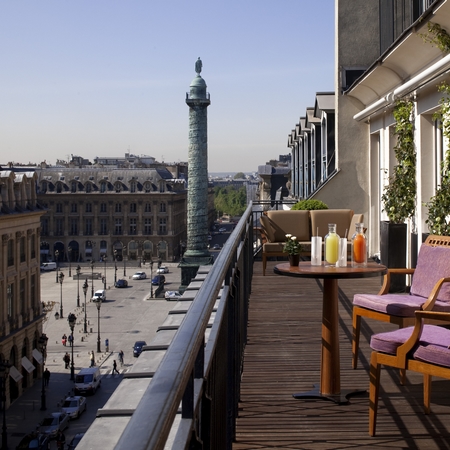Situated in the extremely elegant Place Vendôme between the Opera Garnier and the Louvre, the Paris Ritz is one of the most famous hotels in the world. Synonomous with luxury, its name has entered the English language and the expression “putting on the Ritz” means to dress very fashionably. Founded by César Ritz in 1898, this is an historic diamond that was the residence of choice for artists. A refuge frequented by the intellectual set from Marcel Proust to Fitzgerald and Hemingway who was the famous mainstay of the eponymous bar. The top fashionistas were also regulars. Schiaparelli and Mademoiselle Chanel, who stayed there for 30 years: “The Ritz is my home” she used to say.
On the 3rd of February 1705, Antoine Bitaut de Vaillé, Lord of Vaillé and Counsellor at the Grand Council purchased a plot for £35,000 on the Place Vendôme comprising the Vilette, Coigny and Gramont hotels. In 1897, César Ritz bought the Gramont hotel and had it transformed into a luxury hôtel by the architect Charles Mewès. César Ritz had been General Manager of London’s Savoy hotel and worked in collaboration with the chef, Auguste Escoffier. The hotel opened on the 1st of June 1898 with an ostentatious reception and immediately became the place to be for the fashionable set. César Ritz furnished his hôtel with pieces of the period and all the modern comforts; lift, electricity and water on each floor. Each of the 159 rooms had a telephone too. These were levels of comfort way above the norm for the period with plushly decorated and spacious rooms and suites. He also paid particular attention to hygiene, a matter then very much in vogue, and installed bathrooms and lavatories in each room, something completely unique at the time. In the same vein he banished wallpaper and tapestries, which were considered as hotbeds for microbes. He wanted to make his wealthy clients feel as though they were living in a palace and, together with his architect, took inspiration from the châteaux of Versailles and Fontainebleau. Each room was decorated in a different style: Louis XIV, Regency, Louis XV, etc... The accessories came from the very best manufacturers: Christofle silverware, Baccarat glassware, Rouff table linen – he didn’t skimp on anything. He was also extremely demanding about the level of service provided by his staff and paid a lot of attention to the organisation of the restaurant working to this end with the famous chef, Auguste Escoffier. They developed a system based on teamwork to ensure they could offer clients a wide selection of dishes without excessive delay. A rotational system which enabled them to offer an “à la carte” menu - a major innovation compared to traditional restaurants which offered either a set menu served quickly or à la carte which meant long delays in service. From the outset, the hotel hosted prestigious personalities such as Jean Cocteau, Colette, Paul Morand and the writer, Marcel Proust who lived there on a permanent basis in a private room. During the First World War the Ritz was converted into a military hospital by the Red Cross. Then, during the Golden Twenties, the attraction of Europe and Prohibition attracted the Americans to Europe. Hence in 1921, the hotel management decided to reserve a space on the ground floor to serve drinks – the Café Parisien, a bar for men only which welcomed personalities such as Cole Porter; F. Scott Fitzgerald who wrote “The Diamond as Big as the Ritz” there and Ernest Hemingway. The wife of Charles Ritz had the temerity to frequent this men only bar so, in 1926, the hotel opened a second bar opposite called the Café des Dames subsequently renamed Petit Bar in 1934. In 1940, dur- ing the German Occupation the Luftwaffe, (the Nazi air force), requisitioned part of the Ritz which at that time had 450 employees - unlike Lutetia and the Meurice which were entirely requisitioned. Apparently, the palace was partially saved because César Ritz and his german speaking wife, Marie-Louise were Swiss. Indeed, the hotel was treated as neutral territory. The Luftwaffe installed its headquarters in the building on the rue Cambon whilst its head, Herman Göring took over the imperial suite. The palace continued receiving guests; Art dealers who pillaged works of art for Göring’s personal collection, Arletty with her lover, the Nazi officer Hans Jürgen Soehring and Coco Chanel with her lover Hans Gunther von Dincklage. The hotel remained a luxury palace even during the bombardments. Coco Chanel would go the Ritz’s air raid shelters, preceded by a servant carrying her gas mask on a satin cushion! Dur- ing this period the palace also hid allied pilots, fugitives, Jews and resistance fighters who the staff hid in secret rooms and staff quarters. After the war the Ritz recovered its prestige and welcomed renowned celebrities such as the writer, Ernest Hemingway, who claimed to have come to “personally liberate” the palace on the 25th of August 1944, gun in hand and with a group of resistant fighters. Some of his forgotten notes from 1928 were discovered in a Luis Vuitton suitcase in 1956 and were published posthumously in 1964 under the title, “Paris is a Party.” The actor Charlie Chaplin was a regular as was the stylist Coco Chanel, who lived there in an appartment in the rue Cambon for over 30 years before she died there in 1971 just meters away from her boutique in the same street. The Ritz also welcomed through its doors the Shah of Iran, the writer, Jean-Paul Sartre and the singer, Elton John. But the palace was living off its reputation. Victim of conflicts between shareholders and a lack of investment, its clientele got older. So by 1979 it had become a hotel in decline, which was then sold by Charles Ritz’s widow, Monique to the Egyptian businessman Mohamed Al-Fayed. He invested US$250 millions in a complete renovation whilst still continuing to trade. In order to do this an underground network was put in place using tunnels dug from the Place Vendôme. To a great extent the hotel in the Place Vendôme will always be associated with the legendary Diana and her secret affair. In August 1997, the Princess of Wales and Mohamed al-Fayed’s son, Dodi, the princess’s lover, dined in the hotel’s Imperial suite before their fatal car accident. The fatal end to their last night at the Ritz is en- graved in collective memory.
NEW BIRTH
On the 1st of August 2012, the majestic cast iron doors of the Paris Ritz were closed for the first time since they opened. After the meticulous removal of furniture and works of art carefully conserved so they could be put back, the world’s top specialists in the restoration of historical buildings set to work. The interior decorator, Thierry W Despont and his team were given the delicate task of conserving the magic of the place whilst adding the latest technology.
Now you can enter the hotel from an under- ground car park via a tunnel built under the Place Vendôme. The living rooms provide the Ritz’s legendary refinement offering the unique experience of a private residence with views of a sumptuous French garden.
Regulars can still enjoy the warm atmosphere of the Hemingway bar, taste mature spirits and enjoy the famous cocktails of Colin Peter Field. Carrying on the tradition of innovation and excellence at the Ritz the chef, Nicolas Sale took over the kitchens in 2015. This young chef with 4 stars under his belt found exactly the right magic in the Espadon restaurant to inspire his culinary creations. 71 rooms and 71 suites, each decorated with delicate wood panelling and pastel tapestries, the incarnation of the inimitable French “art de vivre” harmoniously blended with the majesty of the 18th Century. The Ritz Club has also rediscovered its splendour with a fabulous pool and the latest sports equipment. Finally, the Paris Ritz has become, once again, the symbol of the French capital and continues to enjoy its legendary status.
Patricia Courcoux Lepic





